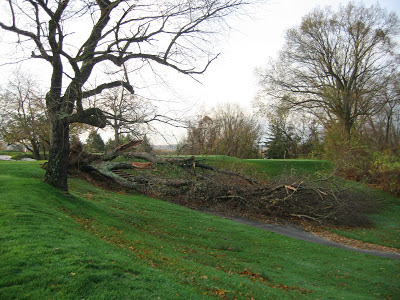Storm Cleanup And Winter Preparation Continues
By Adam Moeller,
agronomist, Northeast RegionNovember 14, 2012
 |
|
| Drill and fill aeration, which is an excellent
deep soil modification strategy, has been performed at many golf courses in
recent weeks. |
|
The damage from Hurricane Sandy continues to be felt in many parts of the
Northeast Region. Clearing of downed trees has been of utmost priority for many
golf facilities. Recent course visits have focused on storm damage with many
reporting 100-plus trees down! Damage from salt water has been showing up in
full force this week for many coastal courses that experienced flooding. Any
saltwater flooded turf that has not greened up may not necessarily be dead, but
it should provide some idea of how extensive the damage could be. Knowing the
severity of damage will be painful, but it will allow the grounds staff to
determine the best plan of action to promote successful recovery.
The damage from Hurricane Sandy was followed by another damaging nor’easter,
which dumped six to 10 inches of wet snow on many golf facilities in New Jersey,
Long Island and Connecticut. This heavy, wet snow was the coup de grâce for many
trees in these areas. In many respects, the damage caused to trees on the golf
course is a blessing in disguise because trees are often very detrimental to
golf course turf. Unfortunately, these storms took down specimen trees at many
facilities in addition to removing undesirable trees, i.e., those casting shade
or interfering with turf health on key playing surfaces. After two consecutive
years with a damaging hurricane and an early snowstorm, perhaps another mild
winter like 2011 will repeat itself as well?
Winter preparations are being made across the region. Many courses have
scaled back mowing operations dramatically to save on labor and improve grass
health as winter draws near. Raising the putting green mowing height is a very
beneficial strategy to reduce the potential for crown hydration and ice
encasement damage. Although putting conditions may be altered, the program is in
the best interest of the grass for next summer. The same is true for the
installation of temporary putting greens in the approaches.
Late season cultivation is also being performed at many facilities in the
region. Drill and fill and/or deep tine aeration are two of the most common late
season cultivation programs for putting greens. Although disruptive to playing
surface, these practices are very beneficial in alleviating soil compaction and
deep modification of the putting green soils.

















